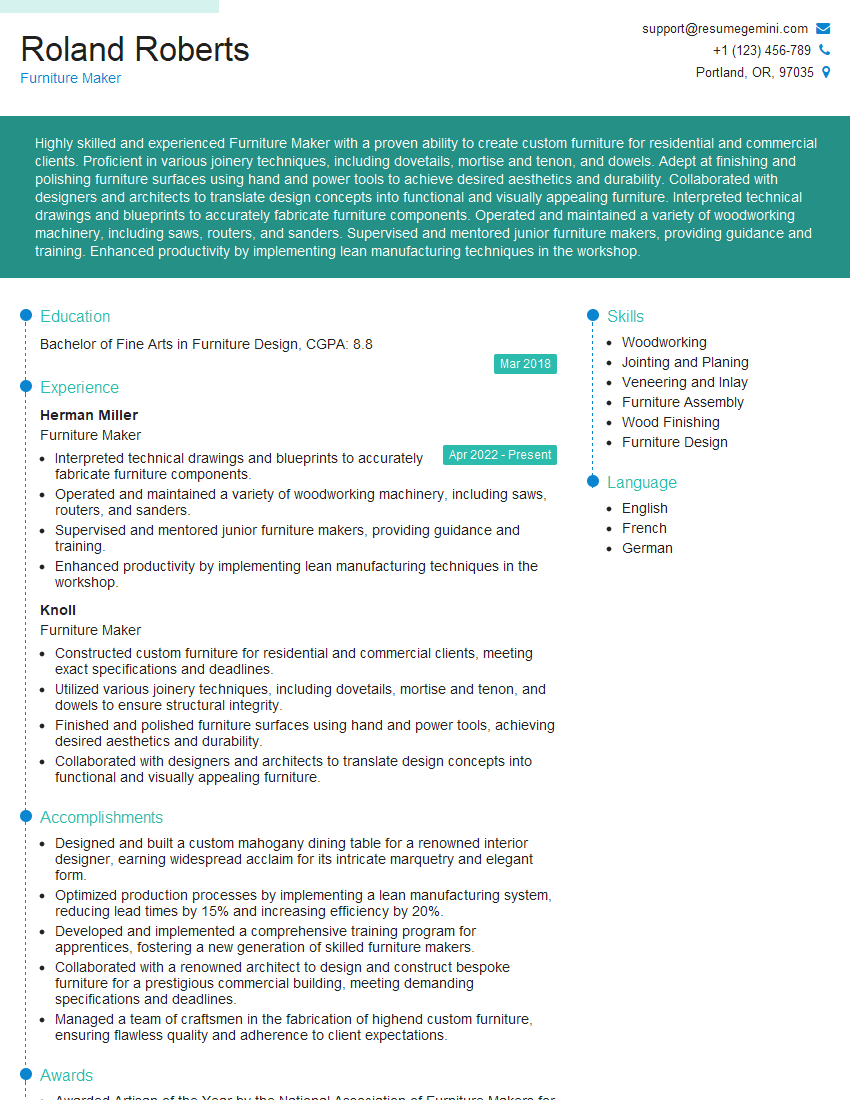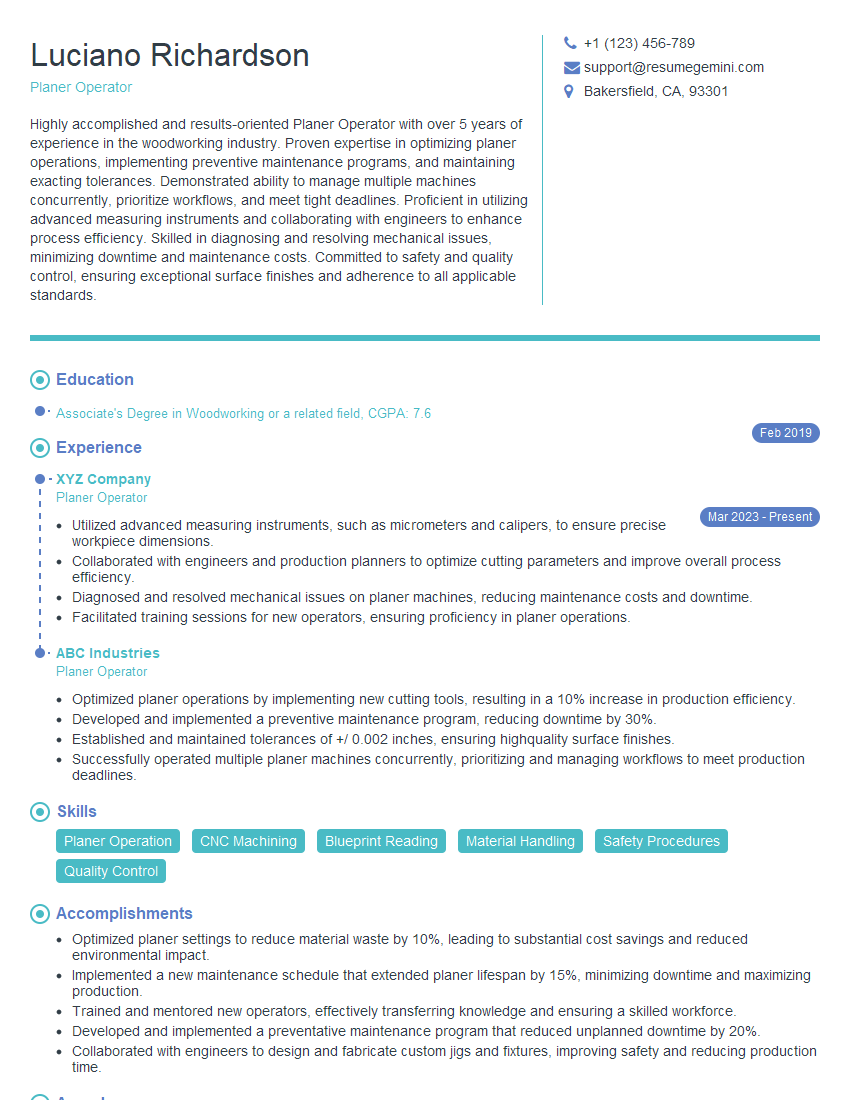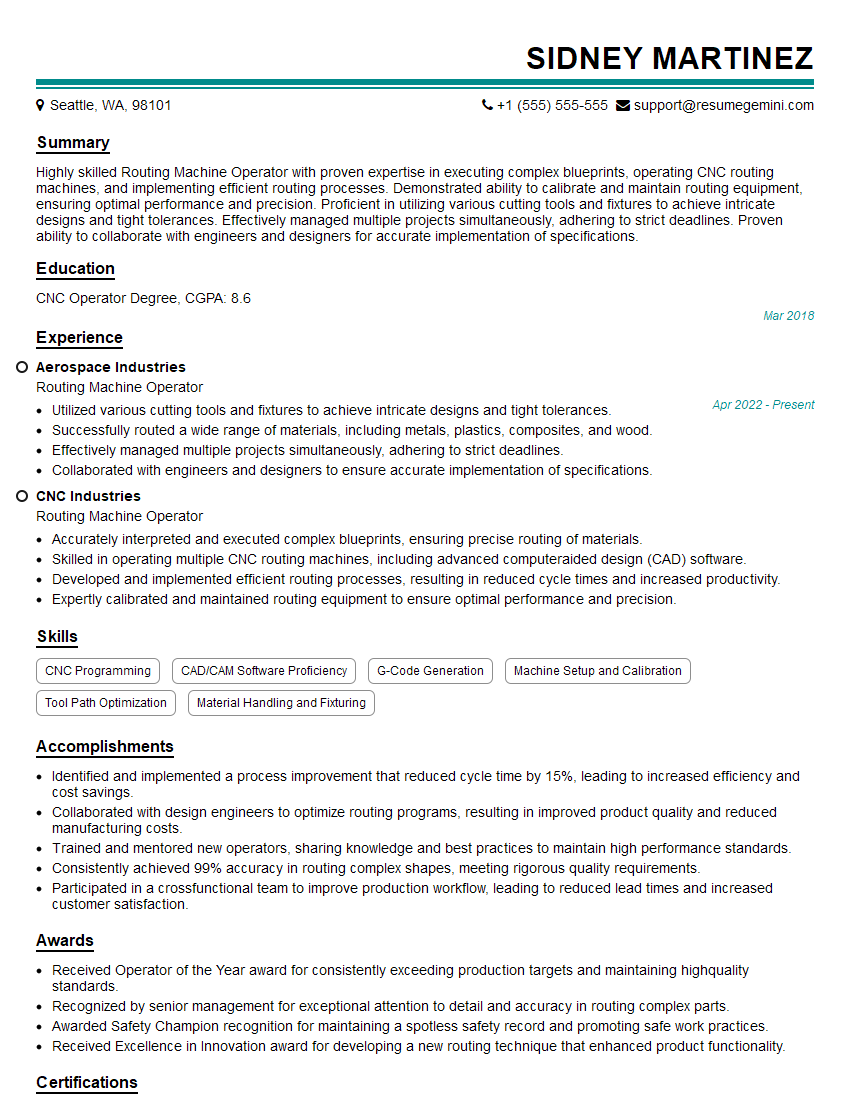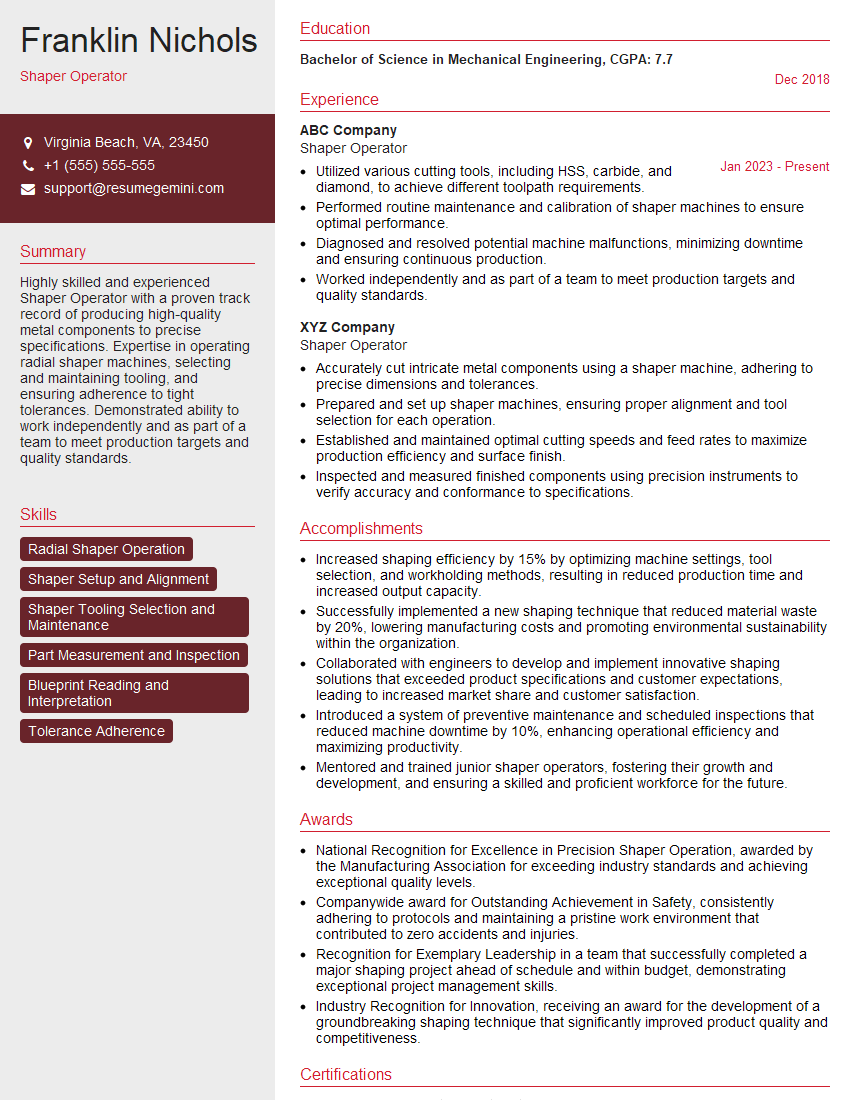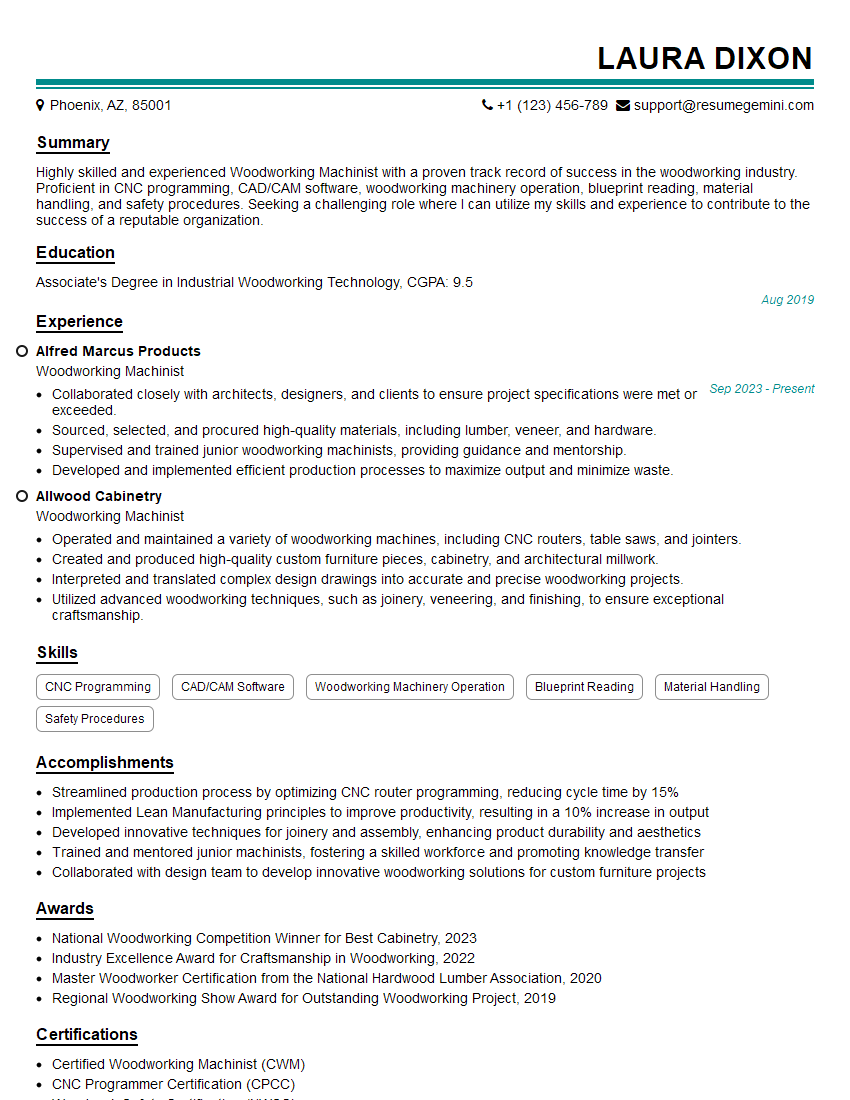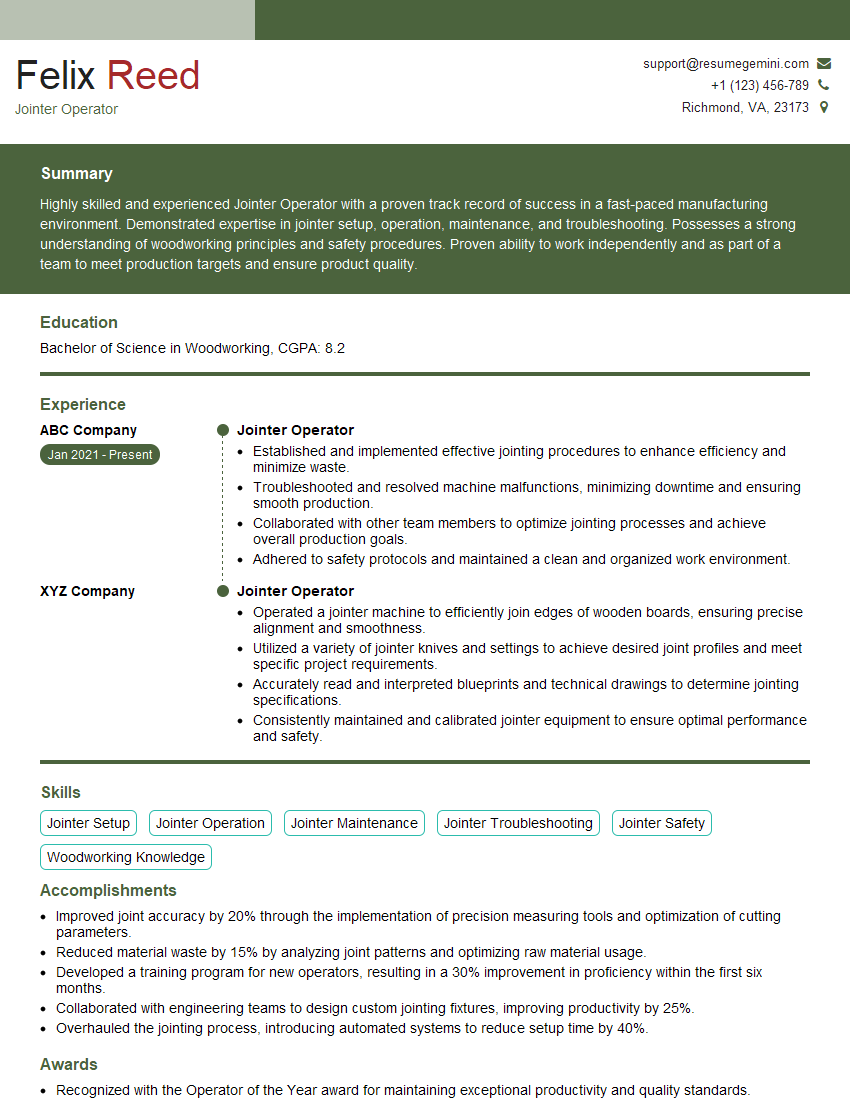The thought of an interview can be nerve-wracking, but the right preparation can make all the difference. Explore this comprehensive guide to Woodworking Machine Operation interview questions and gain the confidence you need to showcase your abilities and secure the role.
Questions Asked in Woodworking Machine Operation Interview
Q 1. Describe your experience with different types of woodworking machinery.
My experience with woodworking machinery spans over 15 years, encompassing a wide range of equipment. I’m proficient in operating and maintaining both traditional and CNC machines. This includes:
- Traditional Machinery: I’m highly skilled in using planers, jointers, table saws, band saws, shapers, drill presses, lathes, and various hand-held power tools. I’ve worked extensively with these machines in both small-scale workshops and larger production facilities.
- CNC Machinery: My expertise extends to CNC routers and CNC lathes. I’m comfortable programming G-code, setting up tooling, and managing complex machining operations on these sophisticated machines. I have experience using various CAM software packages to design and optimize CNC programs.
For example, I recently completed a project involving the creation of intricate wooden components for a custom furniture piece. This project required precise cuts and shaping, which I successfully achieved by using a CNC router programmed with custom G-code, followed by finishing touches using hand tools for a superior product.
Q 2. Explain the safety procedures you follow when operating woodworking machines.
Safety is paramount in woodworking. My safety procedures are unwavering and follow a multi-layered approach:
- Personal Protective Equipment (PPE): I always wear appropriate PPE, including safety glasses, hearing protection, dust masks (especially when working with hardwoods), and appropriate clothing (no loose clothing or jewelry).
- Machine Inspection: Before operating any machine, I thoroughly inspect it for any damage, loose parts, or malfunctions. I ensure all guards and safety devices are in place and functioning correctly.
- Proper Technique: I use proper feeding and handling techniques for each machine to prevent kickback, pinching, or other accidents. I never reach over moving blades or bits.
- Clean and Organized Workspace: Maintaining a clean and organized workspace is essential for preventing trips, falls, and other accidents. I regularly clear away wood scraps and debris.
- Emergency Procedures: I am familiar with the location of emergency shut-off switches and first-aid kits. I’ve received training in emergency response procedures, including how to respond to injuries.
For instance, when operating a table saw, I always use a push stick and featherboard to control the wood, keeping my hands clear of the blade. I never attempt to adjust the blade while it’s running.
Q 3. How do you ensure the accuracy and precision of your work on woodworking machines?
Accuracy and precision are fundamental to quality woodworking. I achieve this through a combination of techniques:
- Proper Machine Setup: Precise setup of the machine is crucial. This includes carefully aligning blades, checking for squareness, and ensuring proper calibration.
- Accurate Measurement: I use precise measuring tools, including calipers, squares, and measuring tapes, to ensure all dimensions are correct before and during the machining process.
- Appropriate Jigs and Fixtures: I frequently employ jigs and fixtures to ensure repeatability and accuracy, especially for repetitive cuts or complex shapes.
- Sharp Tools: Dull tools lead to inaccuracies and increased risk of injury. I regularly sharpen my tools and replace them when necessary. This is critical to achieve clean cuts and reduce tear-out.
- Test Cuts: Before starting a large project, I always make test cuts to verify the machine settings and ensure the results meet the required specifications.
For example, when creating mortise and tenon joints, I use a specialized jig on the router table for consistently sized mortises. This greatly increases speed and ensures an exact fit.
Q 4. What are the common maintenance tasks for woodworking machines?
Regular maintenance is key to extending the lifespan of woodworking machines and ensuring safe operation. My maintenance routine includes:
- Regular Cleaning: Removing sawdust and debris from all machine parts, especially moving parts. Compressed air is often beneficial here.
- Blade/Bit Sharpening and Replacement: Regularly sharpening or replacing blades and bits ensures accuracy and reduces the risk of tear-out.
- Lubrication: Applying appropriate lubricants to moving parts as specified by the manufacturer’s instructions. This is particularly important for machines with bearings.
- Belt Tension and Alignment: Regularly checking and adjusting belt tension and alignment to ensure proper operation.
- Inspection of Safety Features: Periodically inspecting all safety features such as guards and emergency stops to ensure they are functioning correctly.
Ignoring maintenance can lead to costly repairs and even dangerous malfunctions. A well-maintained machine is a safe machine and produces superior results.
Q 5. How do you troubleshoot common issues with woodworking machinery?
Troubleshooting woodworking machines requires a systematic approach. Here’s my strategy:
- Identify the Problem: Clearly define the issue – Is the machine making unusual noises? Are the cuts inaccurate? Is it not powering on?
- Safety First: Disconnect the power supply before attempting any repairs.
- Check Obvious Issues: Inspect for loose connections, broken belts, clogged dust chutes, or other readily apparent problems.
- Consult Manuals: Refer to the machine’s operating manual for troubleshooting guides and diagrams.
- Systematic Elimination: If the problem is not immediately obvious, systematically check each component until the issue is found. For example, if a motor isn’t working, check power supply, wiring, and the motor itself.
- Seek Expert Help: If you cannot resolve the problem, consult a qualified technician.
For example, if a table saw is producing rough cuts, I’d first check blade sharpness, then the alignment of the blade, and finally the fence’s squareness. If the issue persists, I’d consult the manual and if needed, reach out to a professional.
Q 6. What are the different types of wood and their properties?
Wood selection is critical for any woodworking project. Different woods possess unique properties affecting their suitability for various applications. Some key examples include:
- Hardwoods: Generally denser, harder, and more durable than softwoods. Examples include oak (strong, durable), maple (hard, smooth), cherry (beautiful grain, reddish hue), mahogany (rich color, works easily), walnut (strong, rich color).
- Softwoods: Generally less dense, softer, and easier to work with than hardwoods. Examples include pine (affordable, versatile), fir (strong, lightweight), cedar (aromatic, rot-resistant).
The properties to consider are: hardness, density, grain pattern, workability, durability, and color. Oak, for example, is strong and durable, making it ideal for structural components, while pine’s affordability makes it popular for less demanding projects. Understanding these properties ensures you choose the right wood for the job.
Q 7. Explain the process of setting up and operating a CNC woodworking machine.
Setting up and operating a CNC woodworking machine is a multi-step process requiring precision and attention to detail:
- Design and CAD Modeling: Create a detailed digital design of your workpiece using CAD (Computer-Aided Design) software. This step is crucial for accuracy and efficiency.
- CAM Programming: Use CAM (Computer-Aided Manufacturing) software to translate your CAD model into G-code, a set of instructions the CNC machine understands. This includes defining toolpaths, speeds, feeds, and other parameters.
- Machine Setup: Secure the workpiece to the CNC machine’s bed using appropriate clamps and fixtures. Ensure the workpiece is properly aligned and secure to prevent movement during machining.
- Tooling Setup: Select the appropriate cutting tools (bits) for the material and the desired cut. Install the tools accurately in the spindle, ensuring they are properly tightened and aligned.
- G-Code Verification: Before initiating the machining process, verify the generated G-code using the CNC machine’s software to ensure it accurately represents your design and avoids collisions. A dry-run simulation is highly recommended.
- Machining Process: Once the G-code is verified, initiate the machining process and closely monitor the machine’s operation. The machine will automatically execute the G-code instructions.
- Post-Processing: After machining, remove the workpiece from the machine, inspect it for accuracy, and perform any necessary finishing steps.
For example, creating a complex shaped inlay using a CNC router requires careful design in CAD, precise toolpath generation in CAM, and meticulous attention to detail during the setup and operation of the CNC machine. Any errors in these steps can lead to inaccuracies or damage to the workpiece.
Q 8. How do you read and interpret woodworking machine blueprints?
Reading woodworking machine blueprints requires a keen eye for detail and a solid understanding of woodworking principles. It’s like reading a map for your project. The blueprint will typically show dimensions, material specifications, cut lists, and assembly instructions. I start by reviewing the overall design, noting the scale and any annotations. Then, I meticulously examine each view – front, side, and top – to understand the shape and dimensions of each component. Special attention is given to details like angles, dadoes, rabbets, and tenons which dictate the joinery used. For example, a drawing might show a mortise and tenon joint with precise dimensions for both the mortise (the hole) and the tenon (the projection). I’ll also carefully check the material list to ensure I have the right type and quantity of lumber before starting the project. Any discrepancies or unclear aspects are always clarified before proceeding, ensuring a smooth and accurate build.
Q 9. Describe your experience with different cutting tools and their applications.
My experience encompasses a wide range of cutting tools, each suited to specific tasks. Think of them as specialized instruments in a surgeon’s kit. For instance, I’m proficient with various saw blades, from the precise cuts of a fine-tooth rip saw for cutting with the grain to the aggressive cuts of a crosscut saw for cutting across the grain. I also utilize planer blades for smoothing surfaces, router bits for creating intricate profiles and joints (like rabbets or dadoes – recesses in the wood), and chisels for hand-shaping and detailed work. The choice of tool depends heavily on the material, the desired finish, and the complexity of the cut. For example, a delicate carving would require sharp chisels and careful handwork, while a large, rough cut might be efficiently handled with a circular saw. I’m also experienced with specialized blades for tenoning, dadoing, and molding, all contributing to efficient and precise woodworking.
Q 10. How do you ensure the quality of the finished product?
Ensuring quality is paramount. It’s a multifaceted process that starts long before the finishing touches. I begin by carefully selecting high-quality wood, checking for knots, cracks, or other defects. Precise measurements and accurate cuts are crucial from the outset. I employ various checking methods throughout the process; for example, I use a square to ensure right angles, calipers to check dimensions, and a level to ensure surfaces are true. During assembly, I use clamps to hold pieces securely, preventing misalignment and ensuring strong joints. The final inspection includes checking for any imperfections like gaps, uneven surfaces, or loose joints. A final sanding and finishing process creates a smooth, even surface and enhances the beauty of the wood. Think of it like building a house: each step, from the foundation to the roof, needs attention to detail to guarantee a sturdy, beautiful final product.
Q 11. What are your experience with different types of wood joinery techniques?
My experience with wood joinery is extensive, covering a broad spectrum of techniques. These joints are the ‘bones’ of the woodworking structure and their strength and aesthetic appeal are critical. I’m proficient in various techniques, including mortise and tenon joints (strong and durable, commonly used in chairs and tables), dovetail joints (known for their strength and intricate beauty, often seen in drawers), dado joints (excellent for shelving and box construction), rabbet joints (for creating frames and boxes), and miter joints (used for picture frames and boxes, requiring precision). The selection of a particular joint type depends largely on the application, the desired strength, and the aesthetic considerations of the project. For example, I would likely use mortise and tenon joints for a sturdy table leg, while dovetail joints would be more suitable for a high-quality drawer. My proficiency extends to both hand-cut and machine-cut joints.
Q 12. How do you handle material waste and disposal?
Responsible material waste management is a cornerstone of my practice. It’s not just about cleanliness; it’s about environmental responsibility and maximizing resource efficiency. I begin by carefully planning cuts to minimize waste, using efficient techniques and often creating detailed cut lists beforehand. Scraps are meticulously sorted. Larger pieces are saved for future smaller projects, while smaller offcuts can be used for kindling or craft projects. I also adhere strictly to local regulations regarding wood waste disposal; this often involves separating different types of wood and ensuring proper disposal at designated recycling facilities or through appropriate composting methods. Reducing waste isn’t just environmentally sound, it’s also economically beneficial, saving both materials and disposal costs.
Q 13. Explain your understanding of different wood finishing techniques.
Wood finishing is the art of enhancing the natural beauty and protecting the wood. It’s the final flourish that transforms a piece of wood into a stunning piece of craftsmanship. I’m versed in a range of techniques including staining to enhance color and grain, sealing to protect against moisture and decay, and varnishing or lacquering to provide a durable, glossy finish. I’m also experienced with oil finishes, which penetrate the wood, providing both protection and enhancing the wood’s natural beauty. The choice of finish depends heavily on the type of wood, the intended use of the piece and the desired aesthetic outcome. For instance, a robust varnish might be suitable for a table that sees heavy use, while a delicate oil finish would enhance the grain of a fine piece of furniture. Proper preparation, such as sanding and cleaning the wood, is crucial for a flawless, even finish.
Q 14. How do you maintain the sharpness of cutting tools?
Maintaining the sharpness of cutting tools is essential for both safety and quality. A dull tool requires more force to cut, increasing the risk of injury and creating rough, imprecise cuts. My approach is multi-pronged. For hand tools like chisels and plane blades, I regularly hone them using sharpening stones, employing a systematic progression from coarser to finer grits to achieve a keen edge. For machine blades, regular inspection is key. I check for wear, damage, and misalignment. When necessary, I utilize specialized sharpening equipment or replace worn blades to ensure optimal cutting performance and safety. This proactive approach contributes to both efficiency and safety, preventing accidents and ensuring consistently high-quality work. Regular sharpening, much like a musician tuning their instrument, ensures the tools perform at their best.
Q 15. Describe your experience with different types of sanding machines.
My experience with sanding machines spans a wide range of types, from basic hand-held models to large-scale automated systems. I’m proficient with belt sanders, which are excellent for shaping and smoothing larger surfaces due to their continuous abrasive belt. I’ve extensively used disc sanders for intricate work and detail sanding, appreciating their versatility in reaching tight corners and curves. Random orbital sanders are a staple in my workflow; their random motion minimizes swirl marks, resulting in a smoother, more professional finish. Finally, I have experience with spindle sanders, ideal for shaping intricate profiles and creating consistent contours. Each type demands a different technique and understanding of the abrasive’s grit and pressure application to achieve the desired finish. For instance, with a belt sander, aggressive passes require careful control to avoid gouging the wood, while using a random orbital sander requires a lighter touch to avoid overheating and burning the wood.
In one project, I used a combination of belt and random orbital sanders to achieve a smooth, even finish on a large dining table. The belt sander handled the initial shaping and smoothing of the tabletop, while the random orbital sander refined the surface to a flawless finish.
Career Expert Tips:
- Ace those interviews! Prepare effectively by reviewing the Top 50 Most Common Interview Questions on ResumeGemini.
- Navigate your job search with confidence! Explore a wide range of Career Tips on ResumeGemini. Learn about common challenges and recommendations to overcome them.
- Craft the perfect resume! Master the Art of Resume Writing with ResumeGemini’s guide. Showcase your unique qualifications and achievements effectively.
- Don’t miss out on holiday savings! Build your dream resume with ResumeGemini’s ATS optimized templates.
Q 16. How do you measure and adjust the speed and feed rate of woodworking machines?
Measuring and adjusting the speed and feed rate on woodworking machines is crucial for safety, efficiency, and achieving the desired results. Speed, measured in revolutions per minute (RPM), directly impacts the cut quality and the potential for damage. Feed rate, representing the speed at which the workpiece moves through the machine, influences the depth and smoothness of the cut. Both are often adjusted using dials or digital readouts on the machine itself.
For example, on a planer, a slower feed rate and a moderate speed would be appropriate for taking deep cuts, ensuring the wood doesn’t get ripped or torn. A faster feed rate and higher speed might be more suitable for light planing of already-smooth surfaces. With a lathe, the speed is critical for the type of wood and the tool’s size. High speeds work better for fine cuts on harder woods, while lower speeds are necessary for shaping softer woods to prevent tear-out. The proper feed rate depends largely on the tool used and the operator’s skill.
Adjusting the machine settings often requires testing and fine-tuning – making small adjustments and monitoring the results before making substantial changes. Safety always comes first; never exceed the machine’s rated capabilities.
Q 17. What are the safety regulations for operating woodworking machines?
Safety is paramount when operating woodworking machines. Regulations generally include: always using appropriate personal protective equipment (PPE) such as eye protection (safety glasses or a face shield), hearing protection (earplugs or muffs), and dust masks; ensuring proper machine guarding is in place and functioning correctly; never wearing loose clothing or jewelry that could get caught in moving parts; maintaining a clean and organized workspace to prevent accidents; keeping your hands clear of cutting tools and other moving parts; and ensuring the machine is properly lubricated and maintained before each use. Furthermore, regular machine inspections are essential to prevent unexpected failures. Understanding the machine’s operational limits and following the manufacturer’s instructions are critical for safe operation. Before starting any machine, you should ensure you understand the specific safety precautions relevant to that type of equipment.
Q 18. How do you identify and address potential hazards when operating woodworking machines?
Identifying and addressing potential hazards involves a proactive approach. This includes regular machine inspections for loose parts, worn blades, or damaged guards. It’s important to be aware of the specific hazards associated with each machine. For example, table saws pose kickback risks, while jointers can cause pinch points. Proper training and experience help you recognize and avoid these hazards.
A good example is ensuring proper blade alignment on a table saw. A misaligned blade can lead to kickback, a serious safety issue. Regularly checking for blade alignment is essential. If a hazard is identified, address it immediately, and never operate a machine with a known safety issue. If unsure about how to fix an issue, always consult the manufacturer’s instructions or a qualified technician.
Q 19. Explain your experience with automated woodworking systems.
My experience with automated woodworking systems involves programming and operating CNC (Computer Numerical Control) routers and other automated machinery. I’m proficient in using CAD/CAM software to design and generate the necessary G-code for these machines. Understanding the intricacies of toolpaths, feed rates, and material properties is essential for successful operation. This requires attention to detail and a thorough understanding of the machine’s capabilities and limitations.
I have worked on projects involving large-scale production runs where the accuracy and repeatability of automated systems were invaluable. These systems require precision, ensuring the generated code accurately reflects the design and that the machine is set up and maintained appropriately. Regular maintenance is also crucial to prevent downtime and ensure accurate performance.
Q 20. How do you use measuring tools accurately?
Accurate measurement is fundamental in woodworking. I use a variety of tools, selecting the appropriate tool for the task. For precise measurements, I rely on steel rules, calipers, and digital calipers. For marking lines, I use marking gauges, combination squares, and try squares. The choice of tool depends on the task’s precision and scale. For example, I would use calipers for highly accurate measurements of smaller components, while a tape measure would be appropriate for larger projects. Accurate measurement is a combination of using the correct tool and applying appropriate technique; always double-checking measurements to avoid costly mistakes. When measuring, make sure the tool is held firmly and correctly positioned, avoiding parallax errors (errors caused by viewing the measurement at an angle).
Q 21. How do you interpret technical drawings and specifications?
Interpreting technical drawings and specifications is a critical skill. I am proficient in reading and understanding various types of drawings, including orthographic projections, isometric views, and detailed sections. These drawings provide crucial information regarding dimensions, materials, and assembly procedures. Understanding the different symbols, notations, and tolerances is essential for accurately building the intended product.
For example, I can readily identify dimensions, material specifications, and manufacturing tolerances from a blueprint. This information directly informs my material selection, machining techniques, and quality control procedures. Often, a thorough understanding of the drawing and its accompanying specifications is necessary before the project even begins.
Q 22. Describe your experience with different types of woodworking glues and adhesives.
Woodworking glues are the backbone of many projects, and choosing the right one is crucial for success. My experience encompasses a wide range, from the common PVA (polyvinyl acetate) glues to more specialized options like epoxy and polyurethane glues. PVA glues, like Titebond, are water-based, relatively inexpensive, and easy to clean up – ideal for most joinery. They are strong and readily available, perfect for projects where clamping pressure is achievable. However, they’re not suitable for exterior use or applications where high water resistance is critical.
For increased strength and water resistance, I often use polyurethane glues. These are incredibly strong and resistant to moisture, making them perfect for outdoor furniture or projects exposed to the elements. They are more expensive and require a longer clamping time. Epoxy glues, on the other hand, offer incredible bonding strength and versatility. They’re ideal for filling gaps or working with difficult-to-glue materials, though they can be more challenging to clean and require specific mixing ratios for optimal results. Finally, I’ve also worked with animal-hide glues (like hide glue), which are traditional and offer excellent results, but require more precise application and temperature control. The choice depends entirely on the project’s demands and the desired characteristics of the final bond.
Q 23. Explain the difference between different types of wood finishes (e.g., lacquer, polyurethane).
Wood finishes are essential for protecting and enhancing the beauty of the wood. Lacquer, polyurethane, and shellac each have distinct properties. Lacquer dries quickly, offering a hard, durable finish with excellent clarity. It’s a good choice for furniture that needs a tough, scratch-resistant surface and allows for a smooth, easily repaired finish. It often requires multiple thin coats to avoid runs. Polyurethane, available in both oil-based and water-based formulations, offers excellent durability and water resistance, making it ideal for outdoor projects. Oil-based polyurethane produces a richer, more amber tone over time, while water-based options offer quicker drying times and less odor. Shellac, a natural resin finish, is known for its warm tone and buildable nature, offering a beautiful finish but often requiring more maintenance than lacquer or polyurethane.
The decision of which finish to use depends on factors such as the type of wood, the intended use of the piece, the desired aesthetic, and the level of protection required. For example, a delicate antique piece might benefit from the subtle beauty of shellac, while a child’s toy would be better served with the toughness of a polyurethane finish.
Q 24. How do you deal with unexpected issues or machine malfunctions?
Unexpected issues are a part of woodworking. My approach is systematic. First, I assess the situation, ensuring the machine is safely turned off and the area is secured. This prevents further damage and ensures safety. Next, I identify the problem, whether it’s a jammed feed system, a dull blade, or a malfunctioning motor. This step often involves careful observation and sometimes a process of elimination. For minor issues, like a dull blade, I will replace or sharpen the blade as appropriate, following all safety precautions. If the problem is more complex, I’ll consult the machine’s manual, refer to online resources, or seek advice from experienced colleagues. If I cannot resolve it, I’ll initiate the appropriate reporting procedure to get the necessary maintenance or repairs done, ensuring the machine is taken out of service until fixed to avoid further issues or accidents. In every case, safety remains the utmost priority.
Q 25. How do you ensure the safety of yourself and your colleagues while operating woodworking machines?
Safety is paramount in woodworking. My approach to safety starts with a thorough understanding of each machine’s operation and limitations. Before starting any work, I always inspect the machines for damage or loose parts, and ensure all safety guards are correctly installed and functioning. I use appropriate personal protective equipment (PPE), including safety glasses, hearing protection, dust masks, and appropriate clothing. When operating machinery, I ensure no one is in the danger zone, maintaining a safe distance and warning others nearby. Proper cleanup is also crucial – I ensure all debris and loose material are cleared away to prevent tripping or accidents. Regular training and adherence to safety regulations are equally important, as is actively promoting a safe work environment by encouraging colleagues to follow the same safety practices.
Q 26. What is your experience with preventive maintenance of woodworking machinery?
Preventive maintenance is key to extending the lifespan of woodworking machinery and preventing costly repairs. My approach involves a regular inspection schedule, checking for wear and tear, lubrication needs, and any signs of malfunction. I follow manufacturer’s recommendations for lubrication and cleaning, often using specialized lubricants for specific machine components. I regularly check blade sharpness, replace dull or damaged blades promptly, and inspect belts and pulleys for wear. I keep detailed records of maintenance activities, including dates, procedures performed, and any necessary parts replacements. This documentation is invaluable for tracking maintenance history and identifying potential problems early on. Proactive maintenance not only prevents breakdowns but also enhances the accuracy and efficiency of the equipment.
Q 27. How do you stay updated on the latest technologies and techniques in woodworking?
Staying current in woodworking involves continuous learning. I subscribe to woodworking magazines, both print and online, which provide valuable insight into the latest techniques, tools, and technologies. I actively participate in online forums and communities, engaging with other woodworkers and sharing knowledge. I attend woodworking workshops and conferences whenever possible, often learning new techniques from experienced professionals. Exploring online resources like YouTube channels and instructional websites dedicated to woodworking allows me to see practical demonstrations and stay updated on new innovations in machinery and techniques. Staying up-to-date not only enhances my skills but also allows me to apply new knowledge to my work to improve efficiency and produce higher-quality results.
Q 28. Describe a time you had to solve a problem related to woodworking machine operation.
During a project involving intricate joinery on a large table, I encountered a problem with my router causing inconsistent cuts. Initially, I suspected a dull bit. After replacing it, the issue persisted. I systematically checked the router’s base for any misalignment, ensuring it was securely clamped, and confirmed the speed settings were correct. The problem persisted. After careful inspection, I discovered that a small, almost imperceptible amount of wood dust had accumulated between the router’s base and the fence, causing minute variations in the distance between the bit and the wood. A simple cleaning resolved the issue, producing perfectly consistent cuts. This experience highlighted the importance of meticulous attention to detail in woodworking and underscored the fact that sometimes the smallest problems can lead to significant issues in the finished product.
Key Topics to Learn for Woodworking Machine Operation Interview
- Machine Safety and Operation: Understanding lockout/tagout procedures, emergency stops, and safe operating practices for various woodworking machines (e.g., table saws, planers, jointers, routers).
- Material Handling and Selection: Proper techniques for handling different wood types, assessing wood quality, and selecting appropriate materials for specific projects. Understanding the impact of wood grain and moisture content on machining.
- Tooling and Maintenance: Knowledge of various cutting tools, their applications, and maintenance procedures. Recognizing signs of wear and tear and performing basic tool adjustments and sharpening.
- Precision Cutting Techniques: Mastering techniques for accurate cuts, including rip cuts, crosscuts, dadoes, and rabbets. Understanding the principles of accurate setup and alignment.
- Troubleshooting and Problem-Solving: Identifying and resolving common machine malfunctions, understanding the causes of inaccurate cuts or surface finishes, and implementing preventative maintenance strategies.
- Quality Control and Inspection: Inspecting finished work for accuracy, quality, and adherence to specifications. Understanding quality control measures and best practices.
- Reading and Interpreting Drawings: Ability to understand technical drawings, blueprints, and specifications related to woodworking projects.
- Woodworking Joinery: Understanding different types of wood joints (e.g., mortise and tenon, dovetail, dado) and their applications.
- Health and Safety Regulations: Familiarity with relevant health and safety regulations and standards within the woodworking industry.
Next Steps
Mastering woodworking machine operation is crucial for a successful and rewarding career in this skilled trade. It opens doors to diverse opportunities and allows you to contribute your expertise to a wide range of projects. To significantly boost your job prospects, it’s essential to craft a compelling and ATS-friendly resume that highlights your skills and experience effectively. ResumeGemini is a trusted resource that can help you build a professional resume that stands out from the competition. Examples of resumes tailored to Woodworking Machine Operation are available to guide you through the process. Invest time in building a strong resume – it’s your first impression on potential employers.
Explore more articles
Users Rating of Our Blogs
Share Your Experience
We value your feedback! Please rate our content and share your thoughts (optional).
What Readers Say About Our Blog
This was kind of a unique content I found around the specialized skills. Very helpful questions and good detailed answers.
Very Helpful blog, thank you Interviewgemini team.
